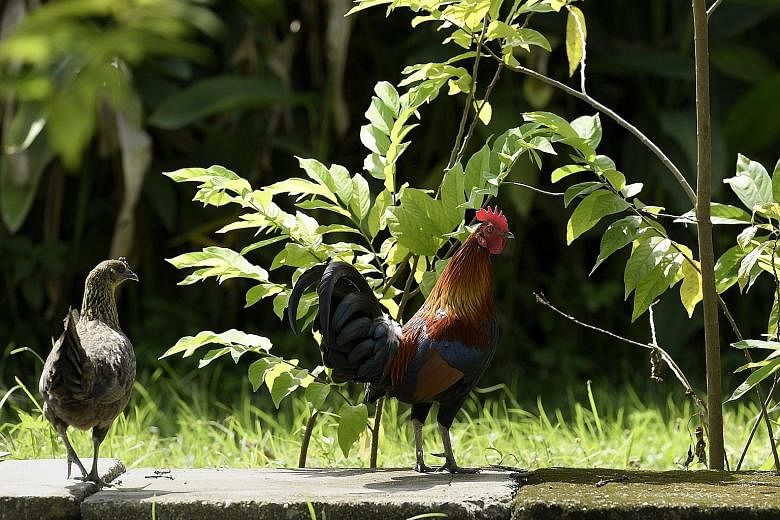The culling of 24 chickens in Sin Ming appeared to have ruffled some feathers in Parliament yesterday.
For almost half an hour, Minister of State for National Development Koh Poh Koon was quizzed on what sparked the move by the Agri-Food and Veterinary Authority (AVA), why the fowls could not have been "re-homed" elsewhere and whether the decision to cull could affect other endangered species.
Mr Louis Ng (Nee Soon GRC) and Non-Constituency MP Daniel Goh led the chorus of questions, asking how the AVA arrives at a decision to cull and whether there is a threshold to the number of public complaints before it takes action.
Their questions followed a public outcry over the AVA's culling of some two dozen free-ranging chickens in Sin Ming last month, after it received 20 complaints about the fowls being noisy.
The AVA had said that it took action to safeguard public health and mitigate nuisance issues.
But its critics said the AVA reacted too quickly to the complaints of a few, especially since there was no immediate bird flu threat.
Yesterday, Dr Koh defended the AVA's action, saying culling is done as a last resort.
He also said that the AVA had found the free-ranging birds in Sin Ming to be a public health risk, and that it did not cull the birds solely because they made a lot of noise.
The flock of free-ranging chickens had grown from 20 in 2014 to more than 50 last year, Dr Koh added. This, in turn, saw more people providing AVA with what Dr Koh called "feedback'': three did so in 2014, five in 2015 and 13 last year.
"Clearly, this correlates with the increased sighting of birds," he said.
He also noted that studies have shown chickens are more susceptible to the bird flu virus than other birds, such as pigeons.
There is scientific evidence that chickens can, in turn, transmit the virus to humans, he added, citing a World Health Organisation report.
He also told the House that the chickens, though free-ranging, were not wild birds.
And to relocate them could harm the genetic stock of native red junglefowl - the endangered ancestor of the domestic chicken - if there is inter-breeding.
But Mr Ng and Associate Professor Goh askedif the culling efforts could mistakenly kill the red junglefowl as well, because members of the two species look alike.
Mr Ng said: "I have seen the photos of the chickens, or some of them at Sin Ming; they are indeed the red junglefowl. There are two birds there, the domestic chickens and the red junglefowl.
"Just to clarify, because AVA had mentioned earlier the free-ranging chickens seen on mainland Singapore are not the red junglefowl. That statement is inaccurate."
In reply, Dr Koh said that the AVA has to conduct genetic studies to ascertain whether the birds "running around are the red junglefowl or just the foreign species", or enlist the help of experts to do so.
"(It) is difficult for us to ascertain the truth just by speaking like this in this House," he added.
The AVA is conducting a study with the National University of Singapore to better understand the ecology and population of selected bird species here, one of which is the free-ranging chicken, Dr Koh said. But most of the 21,000 cases of bird-related feedback received by the AVA in the last three years were about pigeons, said Dr Koh.
Government agencies are working together to tackle bird pests, including mynahs, he said in response to Ms Lee Bee Wah (Nee Soon GRC), Dr Tan Wu Meng (Jurong GRC) and Ms Cheryl Chan (Fengshan SMC).
Meanwhile, he urged residents to stop feeding wildlife. The practice will invariably lead to imbalance and conflict, he said.
Dr Koh also assured the House that the AVA is developing "more effective science-based methods to manage animal populations". It will involve community and animal welfare groups, among others, to explore approaches and solutions.
"Culling will only be done as a last resort," he said.


